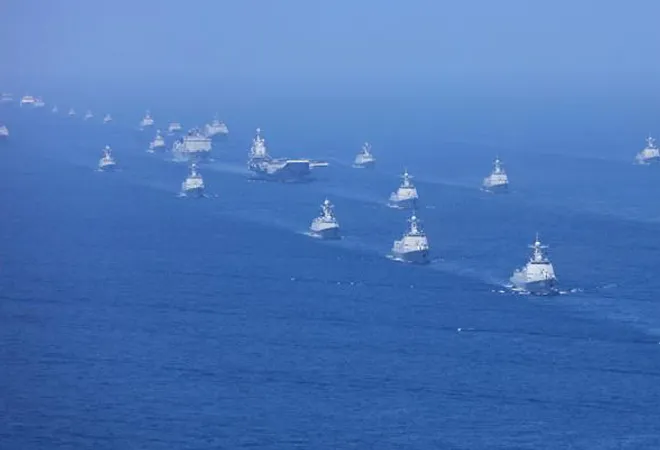
This week, China is slated to hold its largest naval live-fire drill in the Taiwan Strait “involving 10,000 personnel, 48 ships and submarines and 76 fighter jets.” This comes barely a month after China's aircraft carrier, the Liaoning, entered the Taiwan Strait. The carrier was also reported by Taiwanese Defense Minister Yen Teh-fa to have crossed into parts of Taiwan's Air Defence Identification Zone (ADIZ). Considering Chinese President Xi Jingping’s recent warning of the “punishment of history” for any attempt at Taiwanese separatism – the island which Beijing has long-viewed as a wayward province – this recent uptick in Chinese assertiveness vis-à-vis Taiwan cannot be dismissed as singular events. Moreover, it signifies a broader trend in response to the Trump administration’s repeated inclination to employ/stoke the Taiwan ‘issue’ as a transactional lever against Beijing.
The most recent being President Donald Trump’s signing of the ‘Taiwan Travel Act’ which encourages “visits between officials of the United States and Taiwan at all levels”. The act, which challenges – at the very least, the unstated norm of the ‘One China’ policy – to refrain from having high-level exchanges that may be deemed as the U.S. according legitimacy to the government of the ‘Republic of China’, was “firmly opposed” by the Chinese Foreign Ministry. Interestingly, on the day of the Chinese aircraft carrier’s intrusion, the US Deputy Assistant Secretary of State appeared alongside the Taiwanese President at the American Chamber of Commerce in Taipei. In his address, Alex Wong, the senior official of the US Bureau of East Asian and Pacific Affairs, declared the US’ commitment to Taiwan to have “never been stronger” and lauded the island as “an inspiration to the rest of the Indo-Pacific region.” One may argue that these actions by the Trump administration hack away at the very essence of the ‘One China’ policy that has served as the bedrock of contemporary US-China relations.
Since the Nixon normalisation that led to the recognition of the communist regime in Beijing, subsequent US administrations like the Ford, Carter and Reagan dispensations laid down the ‘One China’ policy with joint communiques between the US and China. Overtime, the ‘One China’ policy encompassed America’s acknowledgement of the mainland Chinese position that "there is but one China and that Taiwan is part of China." However, the same stopped short of deeming which of the two – the Republic of China (based in Taipei) or the People’s Republic of China (based in Beijing), represents the ‘One China’. Under Trump, however, this ‘One China’ policy – traditionally aimed to precariously balance America’s commitments towards Taiwan to deter Chinese efforts of unification via force, whilst at the same time maintaining relations with the mainland – has often been deemed as a transactional lever to be employed against Beijing.
In December 2017, when the then President-elect Donald Trump spoke to the Taiwanese President Tsai Ing-Wen in the immediate aftermath of the former’s election victory, the disdain for the ‘One China’ policy was apparent. Talking to Fox News, the President lambasted the policy’s efficacy. Arguing for the use of the ‘One China’ policy as a bargaining chip with China, he said, “I don’t know why we have to be bound by a One China policy unless we make a deal with China having to do with other things, including trade.” Citing US policy interests contemporarily at odds with China, he brandished America to have been “hurt very badly by China with devaluation; with taxing us heavy at the borders when we don’t tax them; with building a massive fortress in the middle of the South China Sea, which they shouldn’t be doing; and, frankly, with not helping us at all with North Korea.” A little over a year into the Trump presidency, however, this transactional approach to Taiwan has not served US interests well on these three avenues – trade, South China Sea and North Korea – that were deemed to be hurting America.
On North Korea’s nuclear brinksmanship, it initially seemed that China was serious about its commitment to see a diplomatic resolution to the issue when it joined Western powers at the UN to slap some of the most crippling sanctions on the Kim Jong Un regime. However, it was eventually reported that China was violating the sanctions that sought to drastically curb trade with the country. American reconnaissance satellite images showed Chinese ships transferring oil to North Korean ships in the West Sea on multiple occasions in violation of UN sanctions. With the recent Xi Jingping-Kim Jong Un meet, it is now clear that China was merely aiming to “recapture its historic leverage over North Korea through coercive diplomacy”.
On the militarisation of the South China Sea, although the Trump administration has increased frequency of ‘Freedom of Navigation’ operations by the U.S. military in the contested areas, the Chinese have hardly been deterred. Recent reports suggest the installation of “military jamming equipment”, and positions “prepared” for the possible deployment of “surface-to-air and anti-ship missiles” on the contested islands over which the Chinese claim territorial sovereignty.
Finally, on China’s trade practices, President Trump has refrained from fulfilling his campaign promise to declare China a “currency manipulator” owing to the $375.2 billion trade deficit between China and the United States. With respect to President Trump’s off-the-cuff declaration of unilateral tariffs on steel and aluminum imports, it is increasingly clear that the same reflects the “president’s preference to punch first and negotiate later.” This was evident in the Trump administration’s desire to coax “fair” deals for the US vis-à-vis multilateral platforms like NAFTA or with allied countries like South Korea.
In the case of China, the chances of Beijing acquiescing to US interests are, however, narrow. Declaring that “China doesn’t hope to be in a trade war, but is not afraid of engaging in one”, China has doubled down with what it deems as the “necessary response” to announce reciprocal tariffs. Some of these tariffs are meticulously aimed at products that hail from regions that were crucial Trump voter bases in the 2016 election. Beijing has thus rendered Trump’s tactic into a game of chicken poised with the possibility of a destabilising trade war between the world’s two largest economies. Thus, far from fulfilling US interests on the avenues cited by Trump, China has consistently outsmarted the ‘deal-maker’ President with rigorous stalemates and sheer indifference for his bluster.
Moreover, playing this ‘Taiwan card’ has only accentuated Beijing’s military “assertiveness” as evidenced in the aforementioned cases. Further, in early-2017, Taiwan’s Defence Minister confirmed China to have deployed Dongfeng 16 (DF-16) medium-range ballistic missiles aimed at Taiwan. In addition, according to Taiwan’s Defense Ministry, the Chinese Air Force conducted in all 16 exercise drills around Taiwan in 2017 alone. Finally, the recent breach of Taiwan’s ADIZ by China’s aircraft carrier was the fourth such incident (with the other three occurring in January 2017, July 2017, and January 2018) since the Trump-Tsai call. In all, a defence review by the Taiwanese Defence Ministry noted 25 drills in Taiwanese airspace and waters conducted by Beijing between mid-2016 to late 2017. Disturbingly, some of these instances even resulted in Taipei scrambling its fighter jets – raising the prospects of miscalculations sparking a broader military confrontation between China and the United States.
The Chinese have also stepped up their rhetoric. At the prospect of President Trump signing the National Defence Authorization Act (NDAA) for Fiscal Year 2018 that contains a provision to consider establishing the “port of call exchanges” between Washington and Taipei’s navies, the Chinese didn’t mince words. At a Chinese embassy event in Washington, Chinese diplomat Li Kexin was reported to have told US officials that, “the day that a US Navy vessel arrives in Kaohsiung (Taiwan’s main port) is the day that our People’s Liberation Army unifies Taiwan with military force”.
Looking forward, the inclination to play the Taiwan ‘Trump’ card is not set to wane. A year into the Trump presidency, it is clear that US foreign policy is perpetually marred not only with policy incoherence and unhinged twitter storms but also with frequent shuffling of the US national security team. The latest being former US Ambassador to the UN John Bolton assuming the National Security Council top job. A Bush-era official, Bolton in the past has expressed views analogous to Trump’s idea of employing Taiwan as a bargaining chip. Moreover, Bolton is infamous for having argued for the US to recognise Taiwan’s statehood to coerce Beijing to withdraw militarily from the South China Sea. Bolton has also suggested stationing US military personnel and assets in Taiwan as the same was argued to be much closer to “East Asia’s mainland and the South China Sea than either Okinawa or Guam, giving US forces greater flexibility for rapid deployment throughout the region should the need arise.”
The effect of this change of guard at the helm of the US national security apparatus is apparent in the recent reports of the Trump administration considering the sale of the F-35 to upgrade Taiwan’s aging air power and deter China. Although certain Congressional Republicans have led that consideration, the prospective sale may stand in lock-step with the Trump administration’s recent heightened rhetoric over the US dutifully fulfilling its commitments towards Taiwan. However, as evidenced, playing this Taiwan ‘Trump’ card may not only be unsuccessful in terms of meeting US interests, but may also further exacerbate Chinese assertiveness.
The author is a Research Fellow at the Observer Research Foundation in Mumbai.
The views expressed above belong to the author(s). ORF research and analyses now available on Telegram! Click here to access our curated content — blogs, longforms and interviews.




 PREV
PREV


